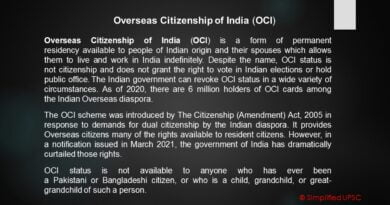MAKE IN INDIA
Context:
EQUIPMENT PRODUCED UNDER “MAKE-IN-INDIA” SCHEME
About:
- Make in India is an initiative by the Government of India to make and encourage companies to manufacture in India and incentivize dedicated investments into manufacturing.
- Government of India lunched this scheme in 2014
- The policy approach was to create a conducive environment for investments, develop a modern and efficient infrastructure, and open up new sectors for foreign capital.
- The government wants to revive the lagging manufacturing sector and spur the growth of the economy.
- The GOI also intends to encourage businesses from abroad into investing in the country and also manufacture here, by improving the country’s ‘Ease of Doing Business’ index.
- The initiative targeted 25 economic sectors for job creation and skill enhancement, and aimed “to transform India into a global design and manufacturing hub.”
“Make in India” had three stated objectives:
- to increase the manufacturing sector’s growth rate to 12-14% per annum;
- to create 100 million additional manufacturing jobs in the economy by 2022;
- to ensure that the manufacturing sector’s contribution to GDP is increased to 25% by 2022 (later revised to 2025).
Contents
Vision: Zero Defect and Zero Effect
If each one of our millions of youngsters resolves to manufacture at least one such item, India can become a net exporter of goods. I, therefore, urge upon the youth, in particular our small entrepreneurs that they would never compromise, at least on two counts. First, zero defect and, second again zero effect. We should manufacture goods in such a way that they carry zero defect, that our exported goods are never returned to us. We should manufacture goods with zero effect that they should not have a negative impact on the environment.
Sectors in focus
For the Make in India campaign, the government of India has identified 25 priority sectors that shall be promoted adequately. These are the sectors where likelihood of FDI (foreign direct investment) is the highest and investment shall be promoted by the government of India.On the campaign launch, the Prime Minister said that the development of these sectors would ensure that the world shall readily come to Asia, particularly to India where the availability of both democratic conditions and manufacturing superiority made it the best destinations, especially when combined with the effective governance intended by his administration.
| Automobiles | Food Processing | Renewable Energy |
| Automobile Components | IT and BPM | Roads and highways |
| Aviation | Leather | Space |
| Biotechnology | Media and Entertainment | Textiles and garments |
| Chemicals | Mining | Thermal Power |
| Construction | Oil and Gas | Tourism and Hospitality |
| Defence manufacturing | Pharmaceuticals | Wellness |
| Electrical Machinery | Ports | |
| Electronic Systems | Railways |
Implications of Make in India:
- After the launch, India gave investment commitments worth ₹16.40 lakh crore (US$230 billion) and investment inquiries worth of ₹1.5 lakh crore between September 2014 to February 2016.
- As a result, India emerged as the top destination globally in 2015 for foreign direct investment (FDI), surpassing the United States and China, with US$60.1 billion FDI.
- As per the current policy, 100% Foreign Direct Investment (FDI) is permitted in all 100 sectors, except for Space industry (74%), defence industry (49%) and Media of India (26%).
- Japan and India had also announced a US$12 billion ‘Japan-India Make-in-India Special Finance Facility” fund to push investment.
- In line with the Make in India, individual states too launched their own local initiatives, such as ‘Make in Odisha,’ ‘Tamil Nadu Global Investors Meet,’ ‘Vibrant Gujarat,’ ‘Happening Haryana’ and ‘Magnetic Maharashtra.’
- India received US$60 billion FDI in FY 2016–17
- The World Bank’s 2019 Ease of Doing Business report acknowledges India’s jump of 23 positions against its rank of 100 in 2017 to be placed now at 63rd rank among 190 countries.
- By the end of 2017, India had risen 42 places on Ease of doing business index, 32 places World Economic Forum’s Global Competitiveness Index, and 19 notches in the Logistics Performance Index, thanks to recent governmental initiatives, which include converges, synergies and enables other important Government of India schemes, such as Bharatmala, Sagarmala, Dedicated Freight Corridors, Industrial corridors, UDAN-RCS, Bharat Broadband Network, Digital India.
- Make in India has not yet achieved its goals.
- The growth rate of manufacturing averaged 6.9% per annum between 2014–15 and 2019-20. The share of manufacturing dropped from 16.3% of GDP in 2014-15 to 15.1% in 2019-20.
Make in India – Advantages
The Make in India campaign has had several positive developments for the country. Below are some more benefits that have been derived from this mission.
- Generating employment opportunities.
- Increasing the GDP by expanding economic growth.
- When FDI inflows become more, the rupee will be strengthened.
- Small manufacturers will get a thrust, particularly when investors from abroad invest in them.
- When countries invest in India, they will also bring with them the latest technologies in various fields.
- Due to the various initiatives taken under the Mission, India has moved up the ranks in the EoDB index.
- Setting up manufacturing centres and factories in rural areas will foster the development of these areas as well.
Why Companies were not manufacturing in India
Make in India campaign is at loggerheads with the Make in China ideal that has gained momentum over the past decade. China is a major rival to India when it comes to the outsourcing, manufacturing, and services business. India’s ailing infrastructure scenario and defunct logistics facilities make it difficult for the country to achieve an elite status as a manufacturing hub. The bureaucratic approach of former governments, lack of robust transport networks, and widespread corruption makes it difficult for manufacturers to achieve timely and adequate production. The NDA led government has vowed to remove these hurdles and make the nation an ideal destination for investors to set up industries.
Challenges faced by Make in India
Even though the campaign has seen success in some quarters, there have been criticisms as well. There are also many challenges facing the country if she is to achieve the lofty targets set by the establishment. Some of the criticisms are laid out below.
- India has about 60% of cultivable land. The thrust on manufacturing is said to affect agriculture negatively. It can even cause a permanent disruption of arable land.
- It is also believed that the rapid industrialization (even with the thrust on “going green”) can lead to a depletion of natural resources.
- A fallout of inviting large-scale FDI is that local farmers and small entrepreneurs may not be able to face the competition from international players.
- The campaign, with all its focus on manufacturing, can cause pollution and environmental side-effects.
- There are serious lacunae in the physical infrastructure facilities in the country. For the campaign to be successful, it is necessary to build up the infrastructure available in the country and also reduce problems like corruption at the lowest levels. Here, India can take lessons from China, which has dramatically improved its share of global manufacturing from 2.6% in the 1990s to 24.9% in 2013. China rapidly developed its physical infrastructure like railways, roadways, power, airports, etc.
Criticism and concerns
The NDA government’s Make In India campaign has till early October attracted INR 2000 crore worth investment proposals. The campaign has, despite this,found its fair share of critics. The topmost of these criticisms is leveled against the incumbent government. It has been felt that the government does not walk its talk – labour reforms and policy reforms which are fundamental for the success of the Make In India campaign have not yet been implemented. A number of layoffs in companies such as Nokia India cast long shadows over the campaign. A number of technology based companies have not been enthused by the campaign launch and have professed to continue getting their components manufactured by China.
Make in India – Schemes
Several schemes were launched to support the Make in India programme. These schemes are discussed below:
- Skill India
This mission aims to skill 10 million in India annually in various sectors. Make in India to turn into a reality, there is a need to upskill the large human resource available. This is important because the percentage of formally skilled workforce in India is only 2% of the population.
The main idea behind this programme is to build an ecosystem that fosters the growth of startups, driving sustainable economic growth, and creating large-scale employment.
- Digital India
This aims to transform India into a knowledge-based and digitally empowered economy. To know more about Digital India, click on the linked page.
- Pradhan Mantri Jan Dhan Yojana (PMJDY)
The mission envisages financial inclusion to ensure access to financial services, namely banking savings & deposit accounts, remittances, credit, insurance, pension in an affordable manner. Click the linked article to know more about Pradhan Mantri Jan Dhan Yojana (PMJDY).
This mission aims to transform and rejuvenate Indian cities. The goal is to create 100 smart cities in India through several sub-initiatives.
AMRUT is the Atal Mission for Rejuvenation and Urban Transformation. It aims to build basic public amenities and make 500 cities in India more livable and inclusive.
This is a mission aimed at making India more cleaner and promoting basic sanitation and hygiene. For more information on Swachh Bharat Mission, click on the linked article.
- Sagarmala
This scheme aims at developing ports and promoting port-led development in the country. Read more on the Sagarmala Project in the linked article.
- International Solar Alliance (ISA)
The ISA is an alliance of 121 countries, most of them being sunshine countries, which lie either completely or partly between the Tropic of Cancer and the Tropic of Capricorn. This is India’s initiative aimed at promoting research and development in solar technologies and formulating policies in that regard.
- AGNII
AGNII or Accelerating Growth of New India’s Innovation was launched to push the innovation ecosystem in the country by connecting people and assisting in commercializing innovations.
Source: PIB
You can find many articles related to SCHEMES (part of GS II) in our website. Go through these articles share with your friends and post your views in comment section.
Discover more from Simplified UPSC
Subscribe to get the latest posts sent to your email.



